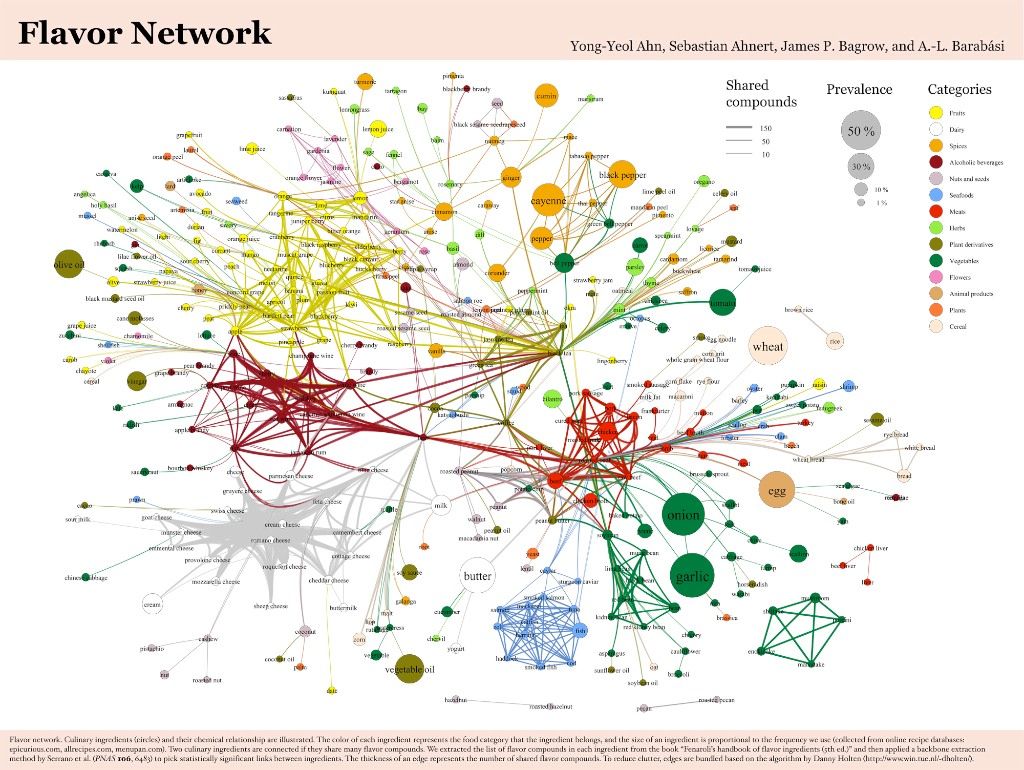日常・その他
The science behind your cookbook.
irina
Over past decades food scientists worked hard exploring the nature of food preferences. Humans tend to combine certain culinary ingredients together and avoid mix some others, but why? Is there anything beyond ethnic traditions and personal preferences? Researchers explored thousands of recipes from all over the world and here’s what they came up with.
Recipes evolution
Over last thousands of years people experimented with food a lot. One of the theories explaining culinary recipes evolution refers to so-called copy-mutate process. Basically, humans tried to mix some ingredients, and based on the results decided to keep few of them to use further on (copy) or substitute the less suitable ones (mutate). This process made some food components abundant in regional cousins, forming staple ingredients distinctive for different ethnic groups.
Flavor

We can describe a flavor of the food as an overall impression based mostly on taste, smell, temperature, and texture. According Foodpairing project, over 80% of what we call taste is actually perceived through food’s aroma, or the flavor. Flavor is represented by aroma compounds (volatile flavor molecules), which trigger our food sensation both through the nose and through the mouth.
Food pairing
One of the popular hypothesis claims that the key to food ingredients compatibility is hidden in their flavor similarity. The concept assumes that food ingredients sharing major flavor components are more likely to taste nice together. This idea inspired some chefs to look for novelty ingredients combination based on scientific evidence. As a result, numerous unexpected food marriages were revealed, among which are caviar and white chocolate, oysters and passion fruit, and many more.
Flavor network
Another study on food composition developed into flavor network, a data-driven structure describing the relationships between separate culinary ingredients. The network was designed to explore possible patterns in culinary components combinations. It’s nodes represent recipe ingredients and the links between them describe the number of shared flavor components.
The study has shown, that regional cuisines can be distinguished by rather small ingredient sets with specific flavors. For instance, North American original recipe components are dairy products, eggs, and wheat. In contrast, East Asian cuisine’s basics are soy sauce, sesame oil, rice, and ginger. The research has also reported that North Americans indeed tend to combine ingredients sharing many flavor components, while East Asians usually mix components with a few or no common aroma molecules.
Color, sound, and more.
Flavor composition is one of the major topics in contemporary food science. However, it doesn’t take into account other meaningful aspects of food perception. Numerous studies have shown that color, for instance, influence our food sensation a lot, the same as the sound we hear while eating.
Food scientists made a massive contribution to our understanding of food composition and food sensation. Nevertheless, the art of culinary, as any other art, lies far beyond scientific patterns and yet can’t be embraced by the most sophisticated scientific models.
Links
Flavor network and the principles of food pairing
Foodpairing project
Kitchen theory – find more about gastrophysics


 2025/01/10
2025/01/10 2024/03/01
2024/03/01 2023/12/01
2023/12/01 2023/06/23
2023/06/23 2023/02/24
2023/02/24 2022/12/16
2022/12/16 2022/06/24
2022/06/24 2022/06/17
2022/06/17